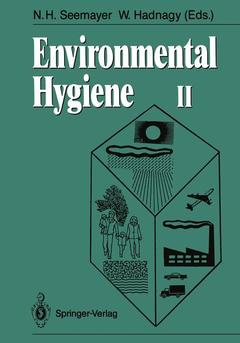Environmental Hygiene II, Softcover reprint of the original 1st ed. 1990
Langue : Français
Coordonnateurs : Seemayer Norbert H., Hadnagy Wolfgang

Environmental Hygiene II deals with the evaluation of environmental pollutants and their relevance to human health. Main topics include mutagenic and carcinogenic activity of environmental chemicals, specific effects of heavy metals, special biological indicators for screening environmental contaminants and monitoring of indoor/outdoor air pollutants. Furthermore, assessment of exposure to environmental and occupational chemicals in man are presented as well as epidemiological studies on the health effects by environmental pollution, studies of inhalation toxicology and strategies and policy of environmental control.
The Medical Institute of Environmental Hygiene at the University of Düsseldorf: A center of environmental research.- Mutagenic and Carcinogenic Activity of Environmental Chemicals.- Mutagenicity of diesel exhaust soot dispersed in phospholipid surfactants.- The role of non-genotoxic mechanisms in carcinogenicity by airborne particulate pollutants.- Genotoxicity of airborne suspended matter determined by in vitro and in vivo short-term assays.- The use of the DNA repair host mediated assay for the detection of genotoxic activity of benzo(a)pyrene, 2-nitrofluorene and airborne particles in vivo.- Systemic genotoxic effects of N-nitrosodimethylamine.- Combination effects of N-nitrosodimethylamine and SO2.- Mutagenic activity of particulates out of electrostatic precipitators in municipal waste incinerators.- Induction of sister chromatid exchanges by food dyes.- Rat tracheal epithelial cells in culture: A model system to study environmental toxins and carcinogens.- Attempt at chemical transformation of fetal human respiratory tract epithelial cells.- Enhancement of cell transformation and induction of sister chromatid exchanges as test systems for detection of seasonal and local differences in genotoxicity of airborne particulates.- Specific Effects of Heavy Metals.- Mutagenicity of carcinogenic metal compounds: Molecular mechanisms.- Interaction of different chromium species with nucleosides.- Lead(II) interferes with the repair and processing of UV-induced DNA damage.- The combination effect of cadmium and X-rays on structural chromosome aberrations in peripheral lymphocytes.- Cytotoxicity of chromium compounds: Comparison of in vitro and in vivo tests.- Antagonism of tetrandrine to neuronal and smooth muscle calcium channels: Comparison with heavy metals.- Special “Biological Indicators” for Screening Environmental Contaminants.- Heavy metal resistance of bacteria as biological indicator for environmental pollution.- Urinary and faecal excretion of metabolites after various modes of administration of polycyclic aromatic hydrocarbons (PAH) to rats.- Effects of carbendazim on the mitotic activity of the small intestine.- Acute toxicity testing of irritant substances in the chick embryo yolk sac blood vessel system.- Description of a granulocyte activating mediator from quartz- and coal mine dust exposed human monocytes/macrophages: New aspects in pathogenesis of pneumoconiosis.- Responses of human lung fibroblasts to ozone.- Selenium and tumorgrowth.- Monitoring of Indoor/Outdoor Air Quality.- Indoor/outdoor pollution ratio in urban and rural areas (related to some chemicals).- Indoor air pollution during vacuum cleaning: Analyses of chemical and biological components.- Determination of hazardous compounds in indoor air: Field studies.- On the preventive concentration limits for asbestos aerosols in ambient and indoor air.- Vehicular traffic and airborne particulate patterns in urban and mountain areas in northeastern U.S A..- Assessment of Exposure to Environmental and Occupational Chemicals in Man.- Occupational and environmental exposure to various aldehydes: Representative assessment of mixed exposure by personal air-sampling with a specific method.- Investigation of the validity of quantitative determination of cadmium and lead in human hair by atomic absorption spectroscopy.- Urinary delta-aminolevulinic acid — an improper screening parameter for occupational and environmental lead exposure.- Cross-sectional epidemiological studies on arsenic excretion in urine of population in areas with different air pollution.- Breath and blood levels of benzene and other volatile aromatic hydrocarbons — Effect of urban air pollution and cigarette smoking.- Effect of chronical toluene exposure on sister-chromatid exchanges and circulating immune complexes.- Occupational exposure to cadmium: Cytogenetic findings in relation to exposure levels.- Chromosome analyses of persons handling cytostatic drugs with and without safety cover.- Epidemiological Studies on Health Effects by Environmental Pollution.- Air pollution, respiratory diseases and virus infections in infants.- Environmental pollution and school children.- Air pollution inhibits the secretion of saliva IgA.- Indoor air pollution by formaldehyde in new and old buildings — Health of children: Epidemiological study.- Influence of Atmospheric Pollutants on Macrophage Structure and Function.- Controlled in vitro approach of low concentration NO2. Effects on human alveolar macrophage functions.- Alveolar macrophage damage by dusts in vitro is correlated with arsenic, lead and antimony contents.- Dust induced alterations of human macrophages.- Effects of quartz and asbestos on alveolar macrophages: Interspecies comparison and cell biological studies.- Comparison of the effects of a high Tc superconducting material (YBa2Cu3O7) and quartz (SiO2) on bovine alveolar macrophages.- Influence of different aldehydes on the chemiluminescence activity of rat alveolar macrophages.- Aerosol Inhalation Studies on Deposition and Clearance.- Magnetic measurement of macrophage activity in human lungs.- Effect of ambient air on a particle clearance parameter of canine alveolar macrophages.- Lung clearance mechanisms of soluble and insoluble compounds.- Postnatal exposure to airborne pollution and heavy metal levels in hearts and lungs of mice.- Human airway diameters derived from aerosol inhalation studies: Effect of inhaled drugs on airway dimensions.- Environmental Chemicals and Lung Cancer.- Lung cancer induction by silica in rats, but not in mice and hamsters: Species differences in epithelial and granulomatous reactions.- Investigation of irritating properties of inhaled CrVI with possible influence on its carcinogenic action.- Proposal for a classification of inhalable fibers according to their carcinogenicity.- New Health Aspects of Environmental Contaminants.- Environmental allergy.- Strategies and Policy of Environmental Control.- Environment and health.- Air pollution control and the work of the National Centre for Air Pollution Prevention in the GDR.- Environment and health data in Europe as a tool for risk management: Needs, uses and strategies.
Date de parution : 03-2012
Ouvrage de 273 p.
17x24.4 cm
Disponible chez l'éditeur (délai d'approvisionnement : 15 jours).
Prix indicatif 105,49 €
Ajouter au panierThèmes d’Environmental Hygiene II :
© 2024 LAVOISIER S.A.S.



